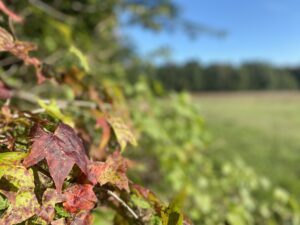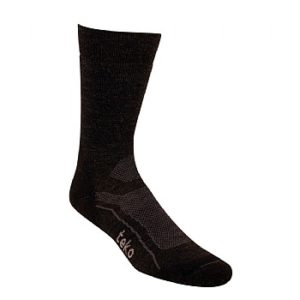Each time we enter a new hiking season, the rules change. For three seasons, the change is significant enough to warrant the requisite reminders. Going into winter, it’s important to remember that the sun sets early, that it gets colder than you may recall, that any weather change needs to be heeded because the stakes for the unprepared are significant. Going into spring, the world is coming back to life — including itchy plants, biting flying creatures and venomous snakes. And summer — drink, drink, drink!
Fall, beautiful, autumnal fall, however, slyly slips under the radar. What could possibly go wrong during these upcoming halcyon days of 70-degree temperatures, cloudless skies, brilliantly colored leaves?
More than you might expect.
 Take a minute, before fall makes its appearance, for these brief bits of advice.
Take a minute, before fall makes its appearance, for these brief bits of advice.
- Ease in. Odds are you haven’t done much serious hiking since the more temperature-friendly days of spring. And nothing sounds more inviting when the forecast high is 65 than to spend as much time as possible on the trail. But remember, it’s been months since you took a long hike; don’t expect to head out and do a 10-miler from the get-go. For one, you likely don’t have as much daylight as you think (see No. 4). And even if you’re capable of doing that long hike, it will take you considerably longer than it did in the spring. Ease in.
- Eat. Likewise, do not look at fall and the prospects of hiking longer as the opportunity to lose weight. We run into this frequently: a hiker suddenly goes weak on the trail — “bonks,” in the vernacular — and we soon learn that he’d only eaten a fig bar for breakfast. Calories are key to getting you down the trail. And we’re not talking empty HoHo and Ding Dong calories, but the nutrient-rich calories found in whole grains, fruits, and nuts. Have a good breakfast, then pack a lunch and snacks.
 Hydrate. In lower temperatures, when we might not sweat as much, we think we don’t need as much water. Not true. Not drinking water is the fastest, surest way to stall your engine, even on a cool fall day. More modest hikers might be averse to drinking water because they don’t want to pee in the woods; you need to embrace the idea that you’ll need to duck behind a tree once or twice a hike. It’s biology, people.
Hydrate. In lower temperatures, when we might not sweat as much, we think we don’t need as much water. Not true. Not drinking water is the fastest, surest way to stall your engine, even on a cool fall day. More modest hikers might be averse to drinking water because they don’t want to pee in the woods; you need to embrace the idea that you’ll need to duck behind a tree once or twice a hike. It’s biology, people.- Note that daylight is shrinking On June 28, the sun set in Raleigh at 8:36 p.m., and there was enough sunlight remaining to see by until a little after 9 p.m. Today, on the last day of August, the sun sets at 7:44 p.m., and by the end of September the sun will have set by 7 and we’ll be losing about a minute of sunlight a day. Sunset creep sneaks up on you. Before determining a start time, check sunset, figure out your estimated hike time, build in some cushion, then set your start time. And pack a headlamp, just in case.
 Check the forecast. There’s never a good season to be caught unawares by not checking the forecast. In fall, a warm afternoon can fall victim to a cold front laden with rain. If you’re not prepared — with an extra layer and rain gear — you could fall victim to hypothermia. And just because it was 80 yesterday doesn’t mean it won’t get out of the 50s today. Always check the forecast before heading out.
Check the forecast. There’s never a good season to be caught unawares by not checking the forecast. In fall, a warm afternoon can fall victim to a cold front laden with rain. If you’re not prepared — with an extra layer and rain gear — you could fall victim to hypothermia. And just because it was 80 yesterday doesn’t mean it won’t get out of the 50s today. Always check the forecast before heading out.- Skip the lines. On fall weekends, several state parks post a similar advisory on their website: expect a wait for parking — if you can even get in the gate. If you really want to visit a more popular park, check out lesser-known access points to avoid the more crowded parking areas (links below). To ensure that you get to see the color you’re stalking, check out websites where groups monitor fall color.
 Be mindful of hunting season. The rules for hunting in North Carolina have changed; most notably, Sunday is no longer a day of rest for hunters in the state. After careful study, the N.C. Wildlife Resources Commission has determined that certain areas will be open to hunting on Sundays, starting this fall. Alas, it could take some digging to find where those areas are (basically, the change would affect lands managed by Wildlife Resources and National Forests where hunting is allowed). Your best bet is to go to the WRC’s Regulations for Specific Game Lands page and learn when hunting is allowed in specific areas. Not sure? Then be sure to wear something that’s bright (neon!) orange.
Be mindful of hunting season. The rules for hunting in North Carolina have changed; most notably, Sunday is no longer a day of rest for hunters in the state. After careful study, the N.C. Wildlife Resources Commission has determined that certain areas will be open to hunting on Sundays, starting this fall. Alas, it could take some digging to find where those areas are (basically, the change would affect lands managed by Wildlife Resources and National Forests where hunting is allowed). Your best bet is to go to the WRC’s Regulations for Specific Game Lands page and learn when hunting is allowed in specific areas. Not sure? Then be sure to wear something that’s bright (neon!) orange.- Practice top-down hiking. This pertains to hikers interested both in exploring the mountains come fall and in finding peak fall color. The latter we will discuss in a couple weeks; the former has mainly to do with hitting your favorite mountain sites before wintry weather sets in and makes them inaccessible, less desirable or both. It can snow atop Mount Mitchell in September and it can get puffy-jacket cold. If cold weather isn’t your thing, fall is the time to practice to-down hiking.
-

Mmmm, merino. Sock it to me. Come fall, it occurs to us to get out the fleece, the long hiking pants, the hat the gloves. But it doesn’t always occur to us to get out our thicker, cool-weather hiking socks. You may not need them immediately, but as fall progresses and the weather cools, you’ll want a thicker, warmer sock. And if you forget, worry not. Your feet will let you know.
- Use sunscreen. Though the days are getting shorter, our neck of the hemisphere is actually getting closer to the sun. That coupled with the thinning canopy means we’re getting more sunshine. Slather up!
- Fall can be a deceptively mellow time to hike. The best way to embrace the mellow? Be prepared for it.
Resources
- Eat: 5 Food Tips for Hiking and Camping from EatRight.org cover the basics. Click here. WildBackpacker offers a more in-depth look into nutrition, here.
- Hydration: If you’re curious about why hydrating is so important, WebMD answers most of your questions in The Quest for Hydration
- Diminishing daylight: Find sunrise and sunset times near you, here.
- Avoid fall’s hot spots. To check on lesser-used access in North Carolina State Parks, go here, for Virginia State Parks, go here.
- Check the forecast. You probably have your favorite site for checking the forecast (we prefer WeatherUnderground.com). For mountain forecasts, we like mountain-forecast.com, which gives the forecast by elevation.
